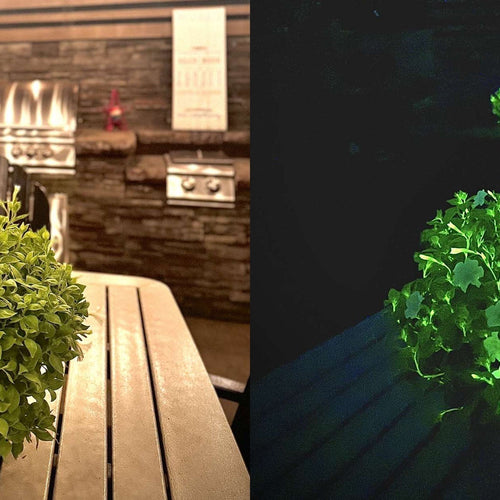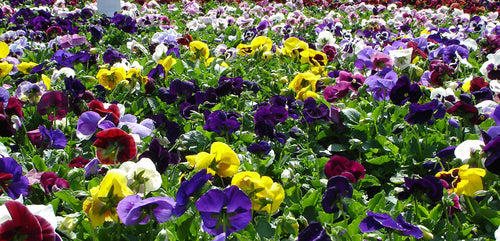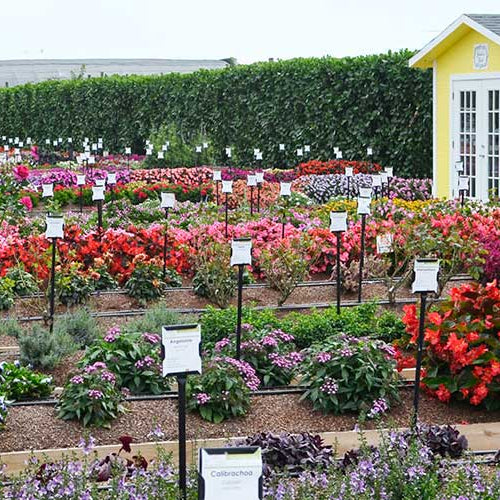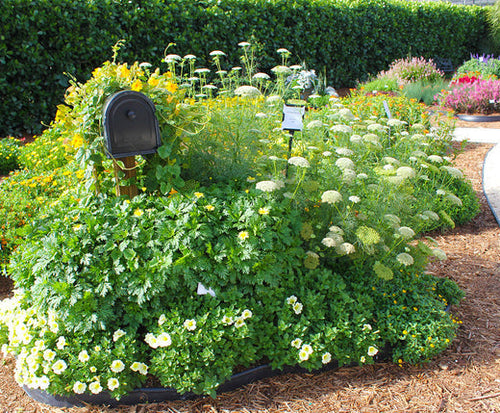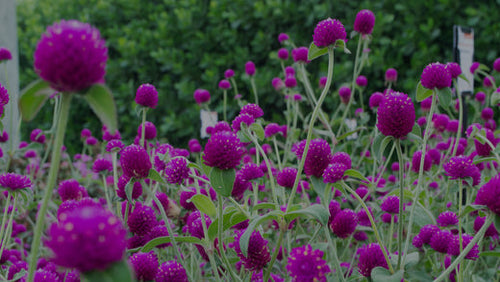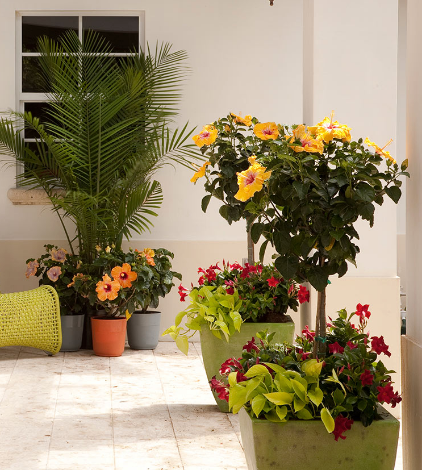By Doug Jimerson

Marigold
In the 1980s there was a nationwide effort to designate marigolds as the official flower of the United States. After all, these reliable annuals have been brightening American gardens for decades. Plus, they are super easy to grow and come in standard-sized varieties that can grow 3 feet tall and minis which reach only a foot or so in height. They also produce yellow, orange, cream, or bi-colored flowers in either single or double forms. Marigolds love full sun and will tolerate dry periods. By the way, the rose edged out the marigold for top honors.
Design Tip:
Marigolds are uniform in size and shape, which makes them a great option if you want to create a river of bloom, right, through your garden.
Learn more about annuals for all seasons.

Coleus
Once relegated to the shady corners of your yard, newer coleus varieties will now also thrive in full sun, making this easy-care annual a great pick for any light conditions you might have. Coleus comes in an almost unlimited selection of colors, shapes, and sizes, from the large-leaved, shade-loving Kong varieties to the bold, sun-loving types such as Wasabi or Redhead. Use sun worshippers in spots that receive at least 6 hours of direct sun a day and shade-loving varieties in spots with less light. All coleus varieties thrive in containers or planted directly in the ground. Heights vary by variety.
Design Tip:
For bold spots of color sprinkle coleus such as Redhead, left, throughout your garden.

Zinnia
Having a bouquet of fresh-cut zinnias on your kitchen table is one of the best ways to celebrate summer. These classic beauties offer a wide variety of colors and sizes with taller varieties (perfect for cutting) growing up to 3 feet tall and compact forms (perfect for containers or border edging) reaching 12 to 18 inches in height. Plus, the more zinnias you cut, the more flowers your plants will produce. The nectar-rich blooms are also popular with hummingbirds and butterflies. Plant zinnias in a sunny spot to keep them in top form.
Design Tip:
Line your driveway with a ribbon of tall zinnias, left. Then you can cut fresh bouquets every time you come home.

Pansy
Cool weather won’t stop pansies from producing a nonstop color show. These little plants rarely grow over 8 inches tall, yet they’ll pack a big punch of color in beds, borders, or containers, especially in the early spring when other flowers are still in the starting gate. Pansies thrive in full sun or partial shade, making them super versatile in the landscape. Pansies also offer an unbelievable assortment of colors, patterns, and forms that look terrific mixed with other flowers or grown in pots or beds by themselves. Water pansies whenever the soil feels dry to the touch and keep picking the flowers to encourage the plants to develop even more blooms.
Design Tip:
Mix different types of pansies together in a window box, left, so you can enjoy them at eye level.

Impatiens
Like coleus, impatiens were once only thought of as a solution for the dark corners of your landscape. Recently, however, everything changed with the introduction of Sunpatiens. These big, bold beauties can grow 3 feet tall and wide in full sun. They also come in a variety of colors--some even have beautiful variegated foliage. Of course, standard impatiens are also still available and remain one of your best choices if you need to brighten up a shady corner of your landscape. Both types of impatiens grow well in containers or directly in the garden. Water whenever the soil just starts to dry out.
Design Tip:
Double the color show in your garden by massing impatiens with variegated foliage.

Petunia
If you’re looking for an easy-care plant with plenty of color options, look no further. Petunias come in almost any color you can think of (even black) in single and double forms. You also have a choice of mounding or trailing forms. Mounding types can grow 12 to 18 inches tall while trailing varieties can stretch 3 to 4 feet across. Both types thrive in containers and landscape plantings. Some petunia varieties also produce a sweet fragrance that’s particularly noticeable on a warm, summer’s night. Petunias are also popular with both hummingbirds and butterflies. You can mix petunias with other flowers or do an all-petunia border selecting varieties in complementary colors. Petunias prefer full sun.
Design Tip:
For a bold effect, do a mass planting of petunias in similar shades. You can see this glorious street-side planting for blocks.

Geranium
No garden is complete without a generous display of geraniums. These long-time favorites seem to get better and better each year as new varieties come onto the market. Unlike old-fashioned geraniums, these new varieties are in almost constant bloom and they are self cleaning, which means the old flower heads fall off on their own. Geraniums also come in two types: seed grown plants and vegetative types that are grown from cuttings. Seed grown geraniums are heavy bloomers, but don’t generally get as large as vegetative varieties. They are also often less expensive. That’s why they’re ideal for big landscape beds where you need a lot of impact for a lower cost. Vegetative geraniums come in a wider assortment of flower, foliage, and form options and look terrific planted in pots, planters, or urns. They pack a big punch in any sunny location.
Design Tip:
Geraniums offer a variety of brilliant foliage options. Mix and match them for the best show.

Verbena
The slightly trailing habit of verbena makes it one your best choices for hanging baskets or window boxes. These beautiful plants produce dozens of rounded flower heads in both solid and bi-colored varieties. The plants also have pretty, finely cut foliage that looks wonderful even during the rare times when the plant is not in bloom. Verbena prefers full sun and a drink whenever the soil feels dry to the touch. To keep your verbena in top form, remove the fading flower heads as they appear. Verbena is also a top pick for visiting butterflies and hummingbirds.
Design Tip:
Plant verbena in a tall container or window box where you can take advantage of the plants’ trailing habit.





